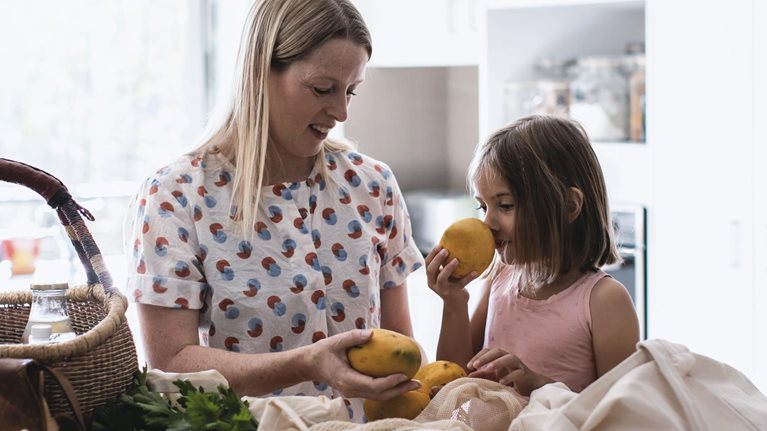Are consumers truly paying more attention to sustainability—or just saying that they are? What are companies doing to ensure that their businesses are both sustainable and profitable? In this episode of the McKinsey on Consumer and Retail podcast, partner Sebastian Gatzer and senior partner Clarisse Magnin discuss highlights from their latest research on sustainability in the consumer sector. An edited transcript of their conversation with executive editor Monica Toriello follows.
Monica Toriello: In the retail and consumer-goods industry, there are a couple of refrains that you often hear about sustainability, and there’s some tension between them. One thing you hear is that sustainability is becoming much more important to all stakeholders, including consumers, regulators, and companies. But another refrain is that people are not that willing to pay for sustainable products and services. There’s an attitude–behavior gap: what people say they’re willing to do differs from what they’re actually willing to do.
To give us a fact-based picture of the state of sustainability in the retail and consumer sector, we have with us today two people who spend a lot of their time on these issues. Let me briefly introduce each of them. Clarisse Magnin is a senior partner in McKinsey’s Paris office. She leads our work in the consumer sector in Europe, the Middle East, and Africa, and she started McKinsey’s Agriculture Practice in France, which she now leads. She also manages the work that McKinsey does globally on the circular economy and has coauthored a number of publications on that topic. Thank you for talking to us today, Clarisse.
Clarisse Magnin: Very happy to be with you.
Subscribe to the McKinsey on Consumer and Retail podcast
Monica Toriello: Sebastian Gatzer is a McKinsey partner based in Cologne, Germany. Sebastian works with leading consumer-goods manufacturers and retailers, advising them on strategic and operational issues and helping them reach their sustainability goals. He has been involved with several recent reports on sustainability, including one titled “The path forward for sustainability in European grocery retail.” Glad to have you with us, Sebastian.
Sebastian Gatzer: Thank you, Monica.
The impact of the COVID-19 pandemic
Monica Toriello: I’d like to start by having you situate us as to how important sustainability is in the consumer sector these days. I’ve heard both viewpoints. Some are saying sustainability is becoming more important and that the pandemic has made people even more concerned about sustainability. But I’ve also heard the opposite: that despite lots of talk, concern about sustainability has died down, and it’s now taking a back seat to other issues. What’s your perspective?
Clarisse Magnin: Our perspective is that the topic has never been as acute as it is right now. And it’s a bit counterintuitive; we did not expect the COVID-19 pandemic to strengthen these trends among consumers. What we see in our consumer research that we conducted across more than 27 countries is that the importance of sustainability, the environment, ESG [environmental, social, and governance], safety, natural products, local sourcing, ethical sourcing, et cetera, is really reinforced.
This is true not only in Europe but across the world. We see that the willingness to pay more for sustainable products is rising across geographies. Structurally, we see also greater environmental regulation. For example, more than 70 countries have put legislation in motion for plastics.
Sebastian Gatzer: During the pandemic, many executives and chief sustainability officers have been asking us, “Is this the end of the sustainability trend? Are hygiene, product safety, and product availability now the top priorities for retail and for grocery in particular? Does this wipe away the topic of sustainability?”
The clear answer is no. It’s the opposite: the pandemic is actually creating momentum. For example, we asked grocery shoppers all over Europe about their willingness to pay more for sustainable products. During the pandemic, the number of people saying, “I am willing to pay more” was at an all-time high across countries. We also asked shoppers about the outlook, and one out of four consumers say they are planning to focus more on environmental issues and will pay more attention to social aspects in their shopping behavior.
One out of four consumers say they are planning to focus more on environmental issues and will pay more attention to social aspects in their shopping behavior.
The consumer willingness to move toward sustainable products is definitely the strongest force at work, and that will be the main driver of change, but of course we also see that there are regulatory aspects now in place and accelerating a lot. For example, 65 percent of global GDP is now under a 2050 net-zero commitment—that means 65 percent of the world economy is committed to becoming carbon neutral. That is changing the business landscape completely. So we feel quite confident that the trend is not only here to stay, but it will fundamentally change the way we think about consumption.
Clarisse Magnin: And to add to what Sebastian is saying, we see consumers caring about sustainability across product categories. We see it in food, of course. The number-one category is vegetables, as well as different types of fresh products—fruits, meat, fish, dairy products, and so on. Interestingly, we see that sustainability advocates skew toward women, Gen Z, and people with higher incomes. But, despite being slightly skewed toward higher-income people, it is a trend that we’ve confirmed across sociodemographic backgrounds.
Commitment and confusion
Monica Toriello: You mentioned the generational component; much has been written and said about the younger demographic groups, in particular Gen Z, being conscious about sustainability when it comes to their buying decisions, and it sounds like your research supports that. Are there specific product categories, attributes, or aspects of sustainability that seem to matter most to Gen Z or to consumers regardless of demographic?
Sebastian Gatzer: Yes, definitely. The importance of sustainability is rising across demographics and across shopper groups. We have raised the question: Is it more important for grocery shoppers than it is for discount shoppers? The truth is that it’s becoming a more important issue across the board. Clarisse mentioned that fresh categories are the number-one priority for a lot of consumers. We’ve seen that meat and fish are some of the top categories where higher-income shopper groups want to make sustainable choices. There are other factors where you can see differences. For example, the younger generation focuses a little bit more on sustainability when they buy snacks.
In nonfood categories, we see that women, for example, focus a lot on sustainability when it comes to cosmetics and skin care. We are talking about different attributes of sustainability here, be it microplastics, be it vegan products. It’s a wide topic. It’s not simply climate change; it’s also social aspects, as well as the way companies do business, that matter to consumers.
Let me give you an example from the grocery industry. I recently talked to the CEO of Kesko, a Nordic retail chain. Kesko is the number-one solar-energy producer in Finland, and the company has worked hard to make sustainability not only a commitment but also part of the company DNA. What I found very interesting was a particular example he gave about a map that consumers and shoppers can now download. The map allows you to track your carbon footprint. Whenever you shop at Kesko, you will see exactly what your impact was on the environment based on what you put in your shopping basket. Similar to how we have been counting calories in the past, people are now counting their carbon emissions.
This kind of customer awareness and transparency is, first of all, a very good development for us as a society. Second, it is increasing loyalty and customer satisfaction for businesses.
Clarisse Magnin: Nevertheless, there is a complication, which is the lack of a definition of “sustainable products.” This makes it difficult to engage consumers. Do you know how many eco- and sustainable labels exist today? More than 463, across 199 countries and 25 sectors. So it’s a very complex landscape, and if it takes a PhD to understand how the product has been produced, it’s obviously not very practical.
We have many challenges with regard to labeling. For principles of local, organic, waste reduction, seasonal, and so on, there is no global standardized labeling, and that’s why we see these wide differences. This can lead to skepticism. We’ve also asked consumers about what they think is a fair representation of how products—food and nonfood—have been produced, and we see some skepticism, with consumers asking questions like: Is the product truly locally grown? Is it sustainably sourced? Is it non-GMO? Is it organic? Is it recycled or recyclable? Does it really use minimal packaging?
We have exactly what Sebastian was describing: a large demand for such products. Yet at the same time, from an offering standpoint, there’s quite a lot of confusion.
The business case for sustainability
Monica Toriello: Earlier, I mentioned the attitude–behavior gap, which I imagine makes CEOs think, “OK, yes, sustainability to some extent is going to become table stakes. But our profits, at least in the short term, are really going to take a hit.” What do you say to the CEO who believes that sustainability and profitability are somewhat incompatible?
Sebastian Gatzer: That’s actually a discussion we are having quite often. It’s fair to ask about the return on investment and the business cases behind different levers and different activities. But the overall theme is that sustainability and improving company performance actually go hand in hand. Of course, sustainability doesn’t come for free, but overall we see that it pays off economically.
I’ll give you three facts to make this a little more tangible. Sustainable products have been a growth driver in the past; across consumer categories, those marketed as sustainable have been growing five to six times faster than the average market. Also, sustainable products come at a high price premium. Consumers say they’re willing to pay a little or even a lot more if they know that those products have been sustainably sourced and produced. Third—and this is one of the most interesting aspects for me that we are heavily discussing with many companies—is the opportunity that comes with sustainability in new business building, green business building.
It’s amazing how many start-ups we are seeing every month that are focusing on the topic of sustainability in the consumer sector. But it’s not only new kids on the block—not just millennials. Established companies can also drive their business and innovate based on the topic of sustainability.
Clarisse Magnin: If you look at the plant-based market, for example, some companies have been very aggressive in marketing the carbon neutrality of their products—and it has really resonated with consumers. Companies are anchoring their marketing and their message around this value proposition. But we’ve also seen companies in the meat industry, for example, embracing the alternative-protein trend and diversifying their portfolio by offering ready-to-cook solutions made of alternative protein. This is interesting; you’re seeing both start-ups and large incumbents embracing those trends.
We’ve done some analysis about the “winners” in sustainability—meaning, the companies that manage to extract value out of sustainability—because, to be fair, it’s a journey. And it’s not an easy one. Part of it is license to operate; part of it is creating a competitive advantage. But the challenge is really monetizing the efforts that are being made across the different steps of the value chain, be it upstream or downstream. This monetization issue is a challenge that we see across companies and across sectors.
Typically, the winners have very big ambitions, starting at the very top—the CEOs. What is interesting is they are spending less time on KPIs [key performance indicators], reporting, and so on. They’re spending a little bit more time training their people to understand what sustainability means. And they’re focusing a little bit more on the what and the how versus the why.
Winners are engaging in bold transformations that are focused on maybe two or three areas, as opposed to “boiling the ocean” on dozens of topics where it’s difficult to differentiate and emerge. Those are some of our key learnings for extracting maximum value out of a sustainability journey.
CEOs are spending less time on KPIs, reporting, and so on, and a little bit more time training their people to understand what sustainability means. And they’re focusing a little bit more on the what and the how versus the why.
Next steps for CEOs
Monica Toriello: One challenge for incumbents is that some of them have historically treated sustainability initiatives as risk management or risk avoidance, whereas attacker brands have sustainability at their core; it’s part of their value proposition, as you say. One of your messages to incumbent companies is that they need to become sustainability driven. How exactly should they do that? What’s your advice to the CEO of a grocery chain or the CEO of a CPG [consumer-packaged-goods] manufacturer who wants to prioritize sustainability?
Clarisse Magnin: First, take stock of where you are. Start with a materiality assessment. Second, pick and choose the few focus areas where you are going to make a big difference. And then engage your customer base. Work with your suppliers. Essentially, rethink your business model, starting with sourcing and logistics.
Consumer-goods companies and retailers have the ability to meet the rising expectations of their consumers while partnering with other players in the value chain. Some players are extremely integrated. For instance, a grocer that has private-label products has the ability to impact the value chain from the field. If you are not integrated with your upstream value chain, you can work with your suppliers to define the specs that you want, to put them on the journey that allows you to reduce your “scope 3” emissions while also creating differentiation. A lot of the impact is going to come from collaborating with both customers and suppliers to find solutions that are systemic and scalable.


